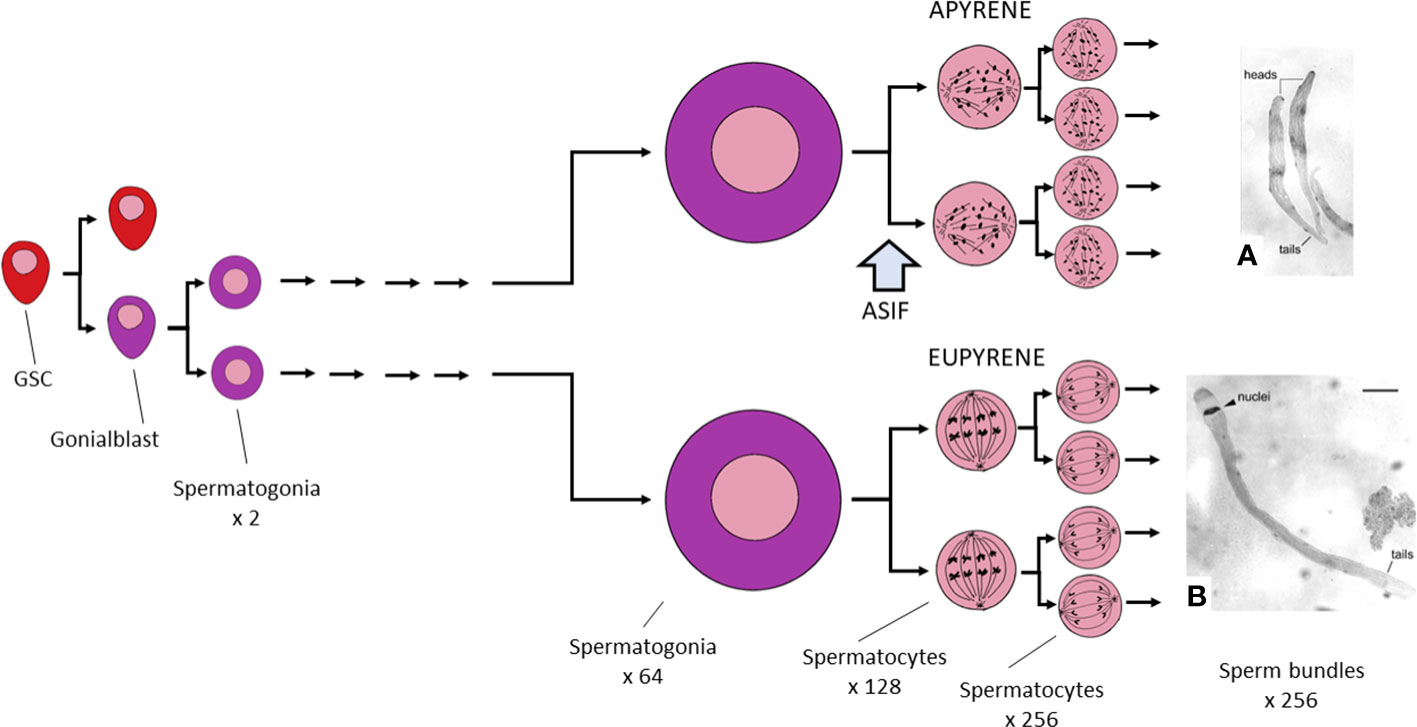Corrigendum: Dichotomous sperm in Lepidopteran insects: a biorational target for pest management
- 1Department of Zoology, University of Delhi, Delhi, India
- 2Department of Life Sciences, University of Bath, Bath, United Kingdom
- 3Milner Centre for Evolution, University of Bath, Bath, United Kingdom
A Corrigendum on
Dichotomous sperm in Lepidopteran insects: a biorational target for pest management
by Seth RK, Yadav P and Reynolds SE (2023) Front. Insect Sci. 3:1198252. doi: 10.3389/finsc.2023.1198252
In the published article, there was an error in Figure 3. At the right-hand side of the figure, the micrographs showing apyrene and eupyrene sperm bundles were inadvertently transposed. The original caption is correct. The corrected Figure 3 and its caption appear below.

Figure 3 Graphic summary of Lepidopteran spermatogenesis. Germline stem cells (GSC) divide asymmetrically to produce a single self-renewing GSC and a single gonialblast. The latter divides to produce two spermatogonia, which then grow remarkably in size while also undertaking five rounds of mitosis. Development is indistinguishable in cysts that will eventually produce eupyrene and those that lead to apyrene sperm. Spermatogonia now enter the prophase of meiosis I, but arrest at this point until the block on meiosis is lifted, probably by exposure to ecdysteroid in the absence of juvenile hormone (JH). At this time, the spermatocyte will become committed to producing a eupyrene sperm unless it is also exposed to a (hypothetical) apyrene sperm stimulating factor (ASIF) that acts to commit the cell to producing an apyrene sperm (see the text for further discussion of this point). From this time onward, eupyrene and apyrene cysts differ in many ways. (A) shows two apyrene sperm bundles; (B) shows a single eupyrene sperm bundle, both from Ephestia kühniella; (A, B) are from reference (40), reproduced with permission.
The authors apologize for this error and state that this does not change the scientific conclusions of the article in any way. The original article has been updated.
Publisher’s note
All claims expressed in this article are solely those of the authors and do not necessarily represent those of their affiliated organizations, or those of the publisher, the editors and the reviewers. Any product that may be evaluated in this article, or claim that may be made by its manufacturer, is not guaranteed or endorsed by the publisher.
Keywords: spermatozoa, sperm activation, sperm motility, initiatorin, serine endopeptidase, Lepidoptera, pest management, RNAi
Citation: Seth RK, Yadav P and Reynolds SE (2024) Corrigendum: Dichotomous sperm in Lepidopteran insects: a biorational target for pest management. Front. Insect Sci. 4:1343089. doi: 10.3389/finsc.2024.1343089
Received: 22 November 2023; Accepted: 31 January 2024;
Published: 16 February 2024.
Edited and Reviewed by:
Bernard Moussian, Université Côte d’Azur, FranceCopyright © 2024 Seth, Yadav and Reynolds. This is an open-access article distributed under the terms of the Creative Commons Attribution License (CC BY). The use, distribution or reproduction in other forums is permitted, provided the original author(s) and the copyright owner(s) are credited and that the original publication in this journal is cited, in accordance with accepted academic practice. No use, distribution or reproduction is permitted which does not comply with these terms.
*Correspondence: Stuart E. Reynolds, s.e.reynolds@bath.ac.uk
 Rakesh K. Seth
Rakesh K. Seth Priya Yadav
Priya Yadav Stuart E. Reynolds
Stuart E. Reynolds